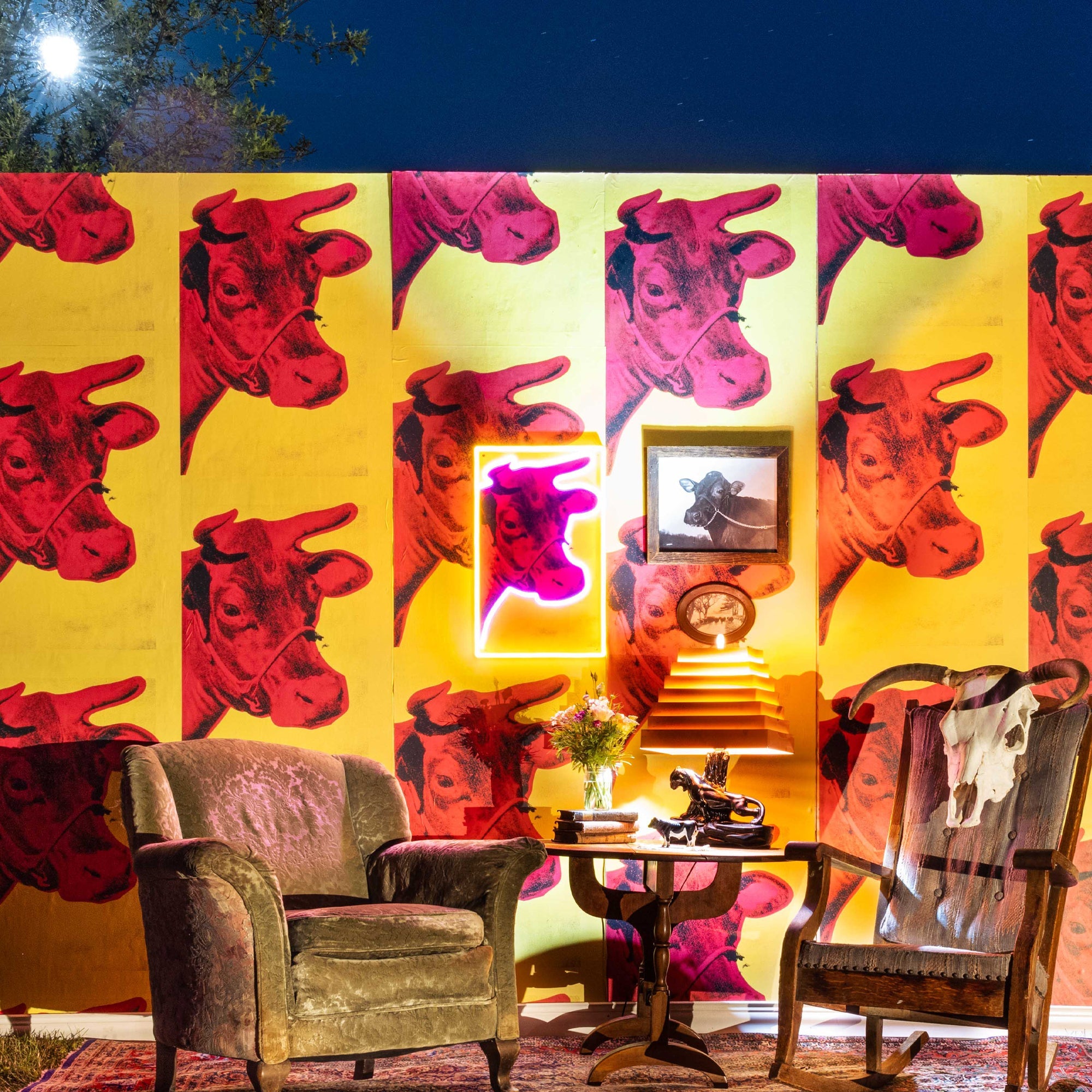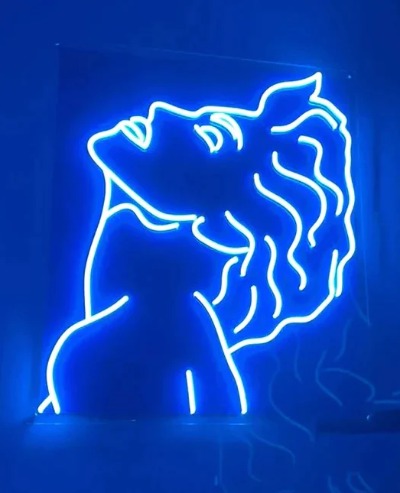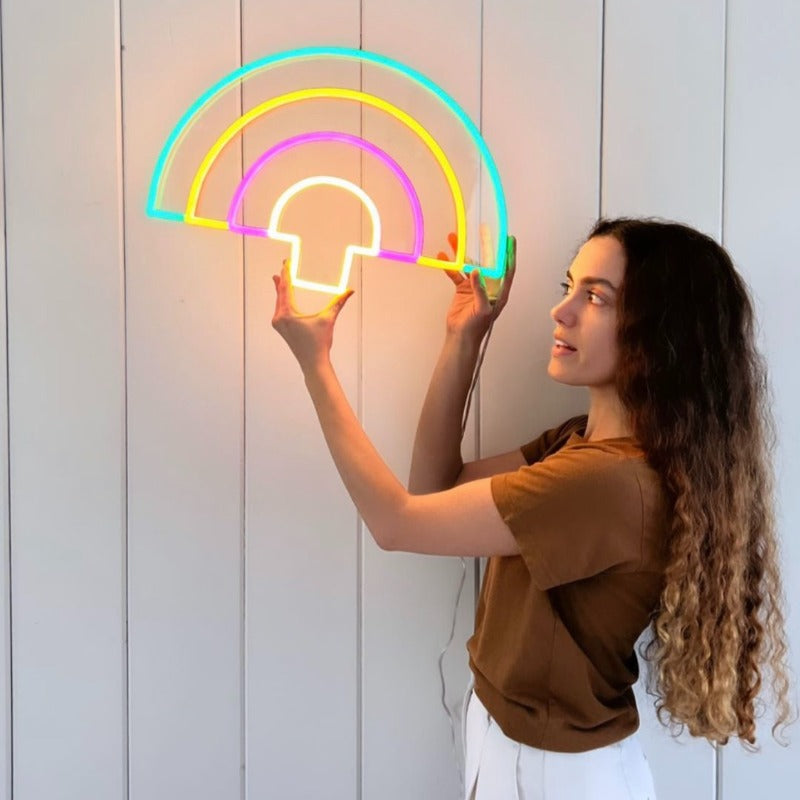
Andy Warhol, the enigmatic father of Pop Art, is even more interesting than his body of work. From his working class roots in Pittsburgh to his eccentric artist parties in New York City, we wanted to create a collection video that reflected his life and times, introducing you to the man behind the iconic artworks that now live in LED neon!
Explore Andy’s artistic world with the following article, then watch our collection video and see how many references you can spot!
Scene One: Scene One: Scene One
Step inside—step inside—inside Andy’s wonderful world of repetition. First exemplified in his Campbell’s Soup Can series, 32 paintings were crafted to look as if they were made by a machine instead of a man. This would become a central theme of Andy’s work.
Repetition is connected to his interest in the mass production culture of 1960s America. He reflected this as much through his “portraits” of everyday products as he did with repetition of these portraits, sometimes featuring subtle changes or experiments with color. It was also used to remove a sense of individuality from his celebrity portraits, revealing the “mass-produced” quality of fame.
Repetition pops up in his personal life, too. According to Andy, he ate the same lunch every day for 20 years!
Scene Two: Andy’s Lens
The foundation of Andy’s work and life was the polaroid camera. He based all of his works on photographs taken by himself or found in newspapers and magazines. Even at his first solo art opening in New York in 1962, Andy wandered around the party, taking photographs with his Minox camera.
Andy’s celebrity portraits, from Elizabeth Taylor to Liza Minelli, started with dozens of polaroids. He utilized these to create the silk-screen prints he painted, resulting in advertisement-style portraits. It was more than just his way of creating art, though. It was his way of connecting with the world.
Andy’s avant garde film work is another example of his societal observation. One of the first films he made in The Factory studio in New York is titled Kiss (1963), and contains various couples kissing in exact increments of 3 ½ minutes each.
Scene Three: Pop Art Origins
Andy Warhol arrived in New York after studying at the Carnegie Mellon University in Pittsburgh, quickly becoming an in-demand commercial artist. He caught the eye of top brands with his unusual style of illustration—especially his shoe images—uncommon for the 50s. Brands that featured his early work include Glamour Magazine, Vogue, Tiffany & Co, and RCA Records.
Andy’s history in advertising became the foundation for what would become known as Pop Art. His work featured “portraits” of items you’d find in a supermarket and collages of brand imagery, using techniques previously limited to the world of advertising. He was fascinated by the consumer culture of 1960s America and how it united people from different backgrounds, using this familiar imagery to create a shared language.
The democratic power of popular culture was an essential aspect of Andy’s challenge to the art world. To Andy, commercial products were as many works of art as the paintings hanging in the Met. It was his way of changing how people saw and experienced the world they lived in.
Scene Four: Nature & Fashion
“Land really is the best art.” While Andy is known as a New York artist, his emphasis on nature reveals the importance of the environment to his life and work. He purchased a house in 1971 on the furthest tip of Long Island in Montauk. He purchased 40 acres of land in Aspen a few years later. While he wanted to build something there, he decided against it, stating that the land was “just too pretty.”
Andy’s floral works also reveal his roots in the 1960s fashion scene. While the term Flower Power is used to describe the act of peaceful resistance, it could also be used to describe the explosion of floral prints and psychedelic patterns in the 60s and 70s. Andy was heavily involved in the fashion scene, attending parties and runway shows, and even participating in a few!
Scene Five: Reinventing the Process
Originally and exclusively used in commercial art, Andy utilized the silkscreen printing process to create pieces that celebrated and criticized the mass production culture of the time.
Andy worked alongside his assistant to transfer the photos, often taken by his camera, onto a mesh silk screen. The canvas was placed beneath this and as he passed an ink-laden squeegee over the mesh, the ink would pass through, imprinting the image onto the canvas.
This allowed Andy to accomplish several things. First, to easily create exact copies of a single work of art, as if the pieces were made by a machine and not a man. Second, it allowed for experimentation with color, creating varied perspectives on a single image. This process caused the art world to question the validity of Warhol’s works as “fine art,” but has since become accepted as another method for creating art.
Scene Six: La Boheme!
Andy is as well-known for his eccentric social life as for his Pop-Art style. He was a patron of the Studio 54 nightclub in New York City, a hot spot for celebrities, artists, and socialites. The most legendary of New York’s clubs, Studio 54 captured the free-wheeling spirit of the 1970s. Many of the people Andy met in Studio 54 would go on to sit for his iconic portraits.
Andy threw artist parties, often hosted in the early years at The Factory. These gatherings were attended by luminaries such as The Rolling Stones, Truman Capote, Salvador Dali, and others.
Outside of the art world, Andy had a hand in everything from filmmaking to modeling and even music. His iconic Banana artwork was created to help an up-and-coming band known as The Velvet Underground.
“Every song has a memory,” explained Andy, “every song has the ability to make or break your heart, shut down the heart, and open the eyes.”
He lived at the very center of the New York art world, influencing and being influenced by its characters, its movements, its dreams.
ANDY WARHOL X YELLOWPOP LIMITED-EDITION COLLECTION IS NOW AVAILABLE TO SHOP HERE.





